Sony CDX-GT565UV User Manual [en, de, fr, it]

Player Disc Compact FM/MW/LW
FM/MW/LW
Compact Disc
Player
4-284-261-22(1)
Operating Instructions |
GB |
|
|
|
|
|
|
|
Bedienungsanleitung |
DE |
|
|
|
|
|
|
|
Mode d’emploi |
FR |
|
|
|
|
|
|
|
Istruzioni per l’uso |
IT |
|
|
|
|
|
|
|
Gebruiksaanwijzing |
NL |
|
|
|
|
|
|
|
To cancel the demonstration (DEMO) display, see page 4.
Zum Deaktivieren der Demo-Anzeige (DEMO) schlagen Sie bitte auf Seite 5 nach.
Pour annuler la démonstration (DEMO), reportez-vous à la page 5.
Per annullare la dimostrazione (DEMO), vedere pagina 5. Om de demonstratie (DEMO) te annuleren, zie pagina 5.
CDX-GT565UV
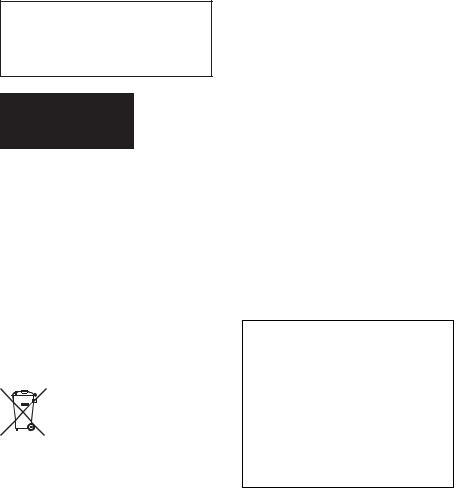
Be sure to install this unit in the dashboard of the car for safety. For installation and connections,
see the supplied installation/connections manual.
This label is located on the bottom of the chassis.
Notice for customers: the following information is only applicable to equipment sold in countries applying EU Directives
The manufacturer of this product is Sony Corporation, 1-7-1 Konan Minato-ku Tokyo, 108-0075 Japan. The Authorized Representative for EMC and product safety is Sony Deutschland GmbH, Hedelfinger Strasse 61, 70327 Stuttgart, Germany. For any service or guarantee matters please refer to the addresses given in separate service or guarantee documents.
Disposal of Old Electrical & Electronic Equipment (Applicable in the European Union and other European  countries with separate collection systems)
countries with separate collection systems)
This symbol on the product or on its packaging indicates that this product shall not be treated as household waste. Instead it shall be handed over to the applicable collection point for the recycling of electrical and electronic equipment.
By ensuring this product is disposed of correctly, you will help prevent potential negative consequences for the environment and human health, which could otherwise be caused by inappropriate waste handling of this product. The recycling of materials will help to conserve natural resources. For more detailed information about recycling of this product, please contact your local Civic Office, your household waste disposal service or the shop where you
2purchased the product.
ZAPPIN and Quick-BrowZer are trademarks of Sony Corporation.
Windows Media is either a registered trademark or trademark of Microsoft Corporation in the United States and/or other countries.
This product contains technology subject to certain intellectual property rights of Microsoft. Use or distribution of this technology outside of this product is prohibited without the appropriate license(s) from Microsoft.
iPhone, iPod, iPod classic, iPod nano, and iPod touch are trademarks of Apple Inc., registered in the U.S. and other countries.
MPEG Layer-3 audio coding technology and patents licensed from Fraunhofer IIS and Thomson.
Warning if your car’s ignition has no ACC position
Be sure to set the Auto Off function (page 19). The unit will shut off completely and automatically in the set time after the unit is turned off, which prevents battery drain. If you do not set
the Auto Off function, press and holduntil the display
disappears each time you turn the ignition off.

Table of contents
Getting Started . . . . . . . . . . . . . . . . . . . . . . . . . . . . . . . . . . . . . . . . . . . . . . . . . . . . . 4
Canceling the DEMO mode . . . . . . . . . . . . . . . . . . . . . . . . . . . . . . . . . . . . . . . . . . . . . . . . 4 Setting the clock . . . . . . . . . . . . . . . . . . . . . . . . . . . . . . . . . . . . . . . . . . . . . . . . . . . . . . . . . . 4 Detaching the front panel . . . . . . . . . . . . . . . . . . . . . . . . . . . . . . . . . . . . . . . . . . . . . . . . . . 4
Location of controls . . . . . . . . . . . . . . . . . . . . . . . . . . . . . . . . . . . . . . . . . . . . . . . . . 5 Radio . . . . . . . . . . . . . . . . . . . . . . . . . . . . . . . . . . . . . . . . . . . . . . . . . . . . . . . . . . . . . 6
Storing and receiving stations. . . . . . . . . . . . . . . . . . . . . . . . . . . . . . . . . . . . . . . . . . . . . . . 6 RDS. . . . . . . . . . . . . . . . . . . . . . . . . . . . . . . . . . . . . . . . . . . . . . . . . . . . . . . . . . . . . . . . . . . . . 7
CD. . . . . . . . . . . . . . . . . . . . . . . . . . . . . . . . . . . . . . . . . . . . . . . . . . . . . . . . . . . . . . . . 9
Playing a disc. . . . . . . . . . . . . . . . . . . . . . . . . . . . . . . . . . . . . . . . . . . . . . . . . . . . . . . . . . . . . 9
USB devices . . . . . . . . . . . . . . . . . . . . . . . . . . . . . . . . . . . . . . . . . . . . . . . . . . . . . . . . 9
Playing back a USB device. . . . . . . . . . . . . . . . . . . . . . . . . . . . . . . . . . . . . . . . . . . . . . . . . . 9
iPod. . . . . . . . . . . . . . . . . . . . . . . . . . . . . . . . . . . . . . . . . . . . . . . . . . . . . . . . . . . . . . 10
Playing back iPod . . . . . . . . . . . . . . . . . . . . . . . . . . . . . . . . . . . . . . . . . . . . . . . . . . . . . . . .10 Operating an iPod directly — Passenger control. . . . . . . . . . . . . . . . . . . . . . . . . . . . . .11
Searching and playing tracks . . . . . . . . . . . . . . . . . . . . . . . . . . . . . . . . . . . . . . . . 12
Playing tracks in various modes. . . . . . . . . . . . . . . . . . . . . . . . . . . . . . . . . . . . . . . . . . . .12 Searching a track by name — Quick-BrowZer™ . . . . . . . . . . . . . . . . . . . . . . . . . . . . . .12 Searching a track by listening to track passages — ZAPPIN™. . . . . . . . . . . . . . . . . . .13
Changing the illumination . . . . . . . . . . . . . . . . . . . . . . . . . . . . . . . . . . . . . . . . . .14
Changing the color of display and buttons — Dynamic Color Illuminator . . . . . . .14 Advanced color setting . . . . . . . . . . . . . . . . . . . . . . . . . . . . . . . . . . . . . . . . . . . . . . . . . . .15
Sound Settings and Setup Menu. . . . . . . . . . . . . . . . . . . . . . . . . . . . . . . . . . . . . . 16
Changing the sound settings. . . . . . . . . . . . . . . . . . . . . . . . . . . . . . . . . . . . . . . . . . . . . . .16 Enjoying sophisticated sound functions — Advanced Sound Engine . . . . . . . . . . . .16 Adjusting setup items . . . . . . . . . . . . . . . . . . . . . . . . . . . . . . . . . . . . . . . . . . . . . . . . . . . .19
Using optional equipment. . . . . . . . . . . . . . . . . . . . . . . . . . . . . . . . . . . . . . . . . . .20
Auxiliary audio equipment . . . . . . . . . . . . . . . . . . . . . . . . . . . . . . . . . . . . . . . . . . . . . . . .20 RM-X114 Remote commander . . . . . . . . . . . . . . . . . . . . . . . . . . . . . . . . . . . . . . . . . . . .21
Additional Information . . . . . . . . . . . . . . . . . . . . . . . . . . . . . . . . . . . . . . . . . . . . . 22
Precautions . . . . . . . . . . . . . . . . . . . . . . . . . . . . . . . . . . . . . . . . . . . . . . . . . . . . . . . . . . . . .22
Maintenance . . . . . . . . . . . . . . . . . . . . . . . . . . . . . . . . . . . . . . . . . . . . . . . . . . . . . . . . . . . .23
Specifications. . . . . . . . . . . . . . . . . . . . . . . . . . . . . . . . . . . . . . . . . . . . . . . . . . . . . . . . . . . .24
Troubleshooting . . . . . . . . . . . . . . . . . . . . . . . . . . . . . . . . . . . . . . . . . . . . . . . . . . . . . . . . .25
3
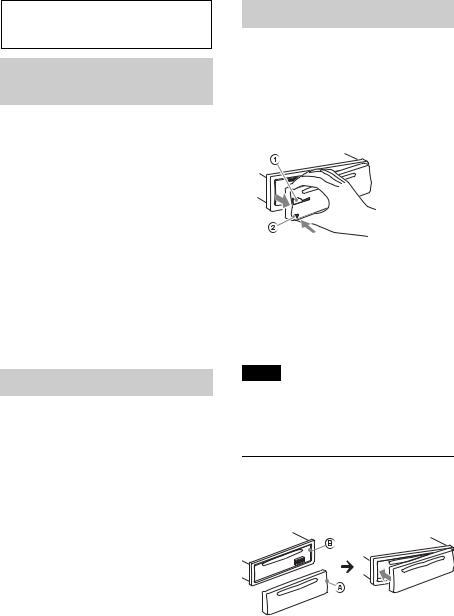
Getting Started
Canceling the DEMO mode
You can cancel the demonstration display which appears during turning off.
1Press and hold the select button.
The setup display appears.
2Rotate the control dial until “DEMO” appears, then press it.
3Rotate the control dial to select “DEMO-OFF,” then press it.
The setting is complete.
4Press  (BACK).
(BACK).
The display returns to normal reception/ play mode.
Setting the clock
The clock uses a 24-hour digital indication.
1Press and hold the select button.
The setup display appears.
2Rotate the control dial until “CLOCKADJ” appears, then press it.
The hour indication flashes.
3Rotate the control dial to set the hour and minute.
To move the digital indication, press
–/+.
4After setting the minute, press the select button.
The setup is complete and the clock starts.
To display the clock, press .
Detaching the front panel
You can detach the front panel of this unit to prevent theft.
1Press and hold .
The unit is turned off.
2Press the front panel release button , then pull it off towards you.
Caution alarm
If you turn the ignition switch to the OFF position without detaching the front panel, the caution alarm will sound for a few seconds. The alarm will only sound if the built-in amplifier is used.
Note
Do not subject the front panel to heat/high temperature or moisture. Avoid leaving it in a parked car or on a dashboard/rear tray.
Attaching the front panel
Engage part Aof the front panel with part Bof the unit, as illustrated, and push the left side into position until it clicks.
4

Location of controls
Main unit
This section contains instructions on the location of controls and basic operations.
SOURCE/OFF button
Press to turn on the power/change the source (Radio/CD/USB/AUX).
Press and hold for 1 second to turn off the power.
Press and hold for more than 2 seconds to turn off the power and the display disappears.
SEEK +/– buttons
Radio:
To tune in stations automatically (press); find a station manually (press and hold).
CD/USB:
To skip tracks (press); skip tracks continuously (press, then press again within about 1 second and hold); reverse/fast-forward a track (press and hold).
ZAP button page 13
To enter ZAPPIN™ mode.
Control dial/select button page 16, 19
To adjust volume (rotate); select setup items (press and rotate).
Disc slot
Insert the disc (label side up), playback starts.
Display window
(eject) button
To eject the disc.
USB connector page 9, 10
 (BACK)/MODE button page 6, 11
(BACK)/MODE button page 6, 11
Press to return to the previous display/ select the radio band (FM/MW/LW). Press and hold to enter/cancel the passenger control.
Front panel release button page 4
Receptor for the remote commander
 (BROWSE) button page 12
(BROWSE) button page 12
To enter the Quick-BrowZer™ mode.
5

AF (Alternative Frequencies)/ TA (Traffic Announcement)/
PTY (Program Type) button page 7
To set AF and TA (press); select PTY (press and hold) in RDS.
Number buttons
Radio:
To receive stored stations (press); store stations (press and hold).
CD/USB:
/ : ALBUM / (during MP3/ WMA/AAC playback)
To skip albums/ (press); skip albums continuously (press and
hold).
: REP* page 12: SHUF page 12
: PAUSE
To pause playback. To cancel, press again.
DSPL (display)/SCRL (scroll) button page 7, 9, 10, 11
To change display items (press); scroll the display item (press and hold).
AUX input jack page 20
* This button has a tactile dot.
Radio
Storing and receiving stations
Caution
When tuning in stations while driving, use Best Tuning Memory (BTM) to prevent an accident.
Storing automatically — BTM
1Press repeatedly until
“TUNER” appears.
To change the band, press repeatedly. You can select from FM1, FM2, FM3, MW or LW.
2Press and hold the select button.
The setup display appears.
3Rotate the control dial until “BTM” appears, then press it.
The unit stores stations in order of frequency on the number buttons.
Storing manually
1While receiving the station that you
want to store, press and hold a number button ( to ) until “MEM” appears.
Receiving the stored stations
1Select the band, then press a number button ( to ).
6

Tuning automatically
1Select the band, then press +/– to search for the station.
Scanning stops when the unit receives a station. Repeat this procedure until the desired station is received.
Tip
If you know the frequency of the station you want to listen to, press and hold +/– to locate
the approximate frequency, then press+/– repeatedly to fine adjust to the
desired frequency (manual tuning).
RDS
FM stations with Radio Data System (RDS) service send inaudible digital information along with the regular radio program signal.
Notes
•Depending on the country/region, not all RDS functions may be available.
•RDS will not work if the signal strength is too weak, or if the station you are tuned to is not transmitting RDS data.
Changing display items
Press .
Setting AF (Alternative
Frequencies) and TA (Traffic
Announcement)
AF continuously retunes the station with the strongest signal in a network, and TA provides current traffic information or traffic programs (TP) if received.
1Press repeatedly until the desired setting appears.
Select |
To |
AF-ON |
activate AF and deactivate |
|
TA. |
|
|
TA-ON |
activate TA and deactivate |
|
AF. |
|
|
AF/TA-ON |
activate both AF and TA. |
|
|
AF/TA-OFF |
deactivate both AF and TA. |
|
|
Storing RDS stations with the AF and TA setting
You can preset RDS stations along with the AF/TA setting. If you use the BTM function, only RDS stations are stored with the same AF/TA setting.
If you preset manually, you can preset both RDS and non-RDS stations with the AF/TA setting for each.
1Set AF/TA, then store the station with BTM or manually.
Receiving emergency announcements
With AF or TA on, the emergency announcements will automatically interrupt the currently selected source.
Tip
If you adjust the volume level during a traffic announcement, that level will be stored into memory for subsequent traffic announcements, independently from the regular volume level.
7

Staying with one regional program
— REGIONAL
When the AF function is on: this unit’s factory setting restricts reception to a specific region, so you will not be switched to another regional station with a stronger frequency.
If you leave this regional program’s reception area, set “REG-OFF” in setup during FM reception (page 19).
Note
This function does not work in the UK and in some other areas.
Local Link function (UK only)
This function enables you to select other local stations in the area, even if they are not stored on your number buttons.
1During FM reception, press a number button ( to ) on which a local station
is stored.
2Within 5 seconds, press again a number button of the local station.
Repeat this procedure until the local station is received.
Selecting PTY (Program
Types)
Displays the currently received program type. Also searches your selected program type.
1Press and hold (PTY) during
FM reception.
The current program type name appears if the station is transmitting PTY data.
2Rotate the control dial until the desired program type appears, then press it.
The unit starts to search for a station broadcasting the selected program type.
Type of programs
NEWS (News), AFFAIRS (Current Affairs), INFO (Information), SPORT (Sports), EDUCATE (Education), DRAMA (Drama), CULTURE (Culture), SCIENCE (Science), VARIED (Varied), POP M (Pop Music), ROCK M (Rock Music), EASY M (M.O.R. Music), LIGHT M (Light classical), CLASSICS (Serious classical), OTHER M (Other Music), WEATHER (Weather),
FINANCE (Finance), CHILDREN
(Children’s program), SOCIAL A (Social Affairs), RELIGION (Religion), PHONE IN (Phone In), TRAVEL (Travel), LEISURE (Leisure), JAZZ (Jazz Music), COUNTRY (Country Music), NATION M (National Music), OLDIES (Oldies Music), FOLK M (Folk Music), DOCUMENT (Documentary)
Setting CT (Clock Time)
The CT data from the RDS transmission sets the clock.
1 Set “CT-ON” in setup (page 19).
Note
The CT function may not work properly even though an RDS station is being received.
8
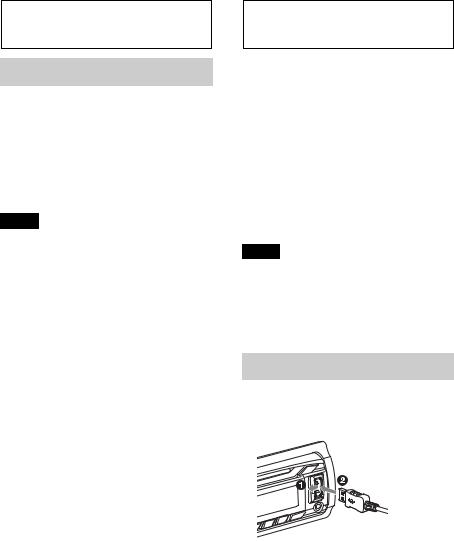
CD
Playing a disc
This unit can play CD-DA (also containing CD TEXT) and CD-R/CD-RW (MP3/ WMA/AAC files (page 22)).
1Insert the disc (label side up).
Playback starts automatically.
To eject the disc, press .
Note
When ejecting/inserting a disc, keep any USB devices disconnected to avoid damage to the disc.
Changing display items
Displayed items may differ depending on
the disc type, recording format and settings. Press .
USB devices
•MSC (Mass Storage Class)-type USB devices compliant with the USB standard can be used.
•Corresponding codec is MP3 (.mp3), WMA (.wma), AAC (.m4a) and AAC (.mp4).
•Backup of data in a USB device is recommended.
For details on the compatibility of your USB device, visit the support site on the back cover.
Note
Connect the USB device after starting the engine. Depending on the USB device, malfunction or damage may occur if it is connected before starting the engine.
Playing back a USB device
1Open the USB cover, then connect the USB device to the USB connector with its USB cable.
Playback starts.
If a USB device is already connected, to start playback, press repeatedly
until “USB” appears.
To stop playback, press and hold
for 1 second.
To remove the USB device, stop the USB playback, then remove the USB device.
9

Notes
•Do not use USB devices so large or heavy that they may fall down due to vibration, or cause a loose connection.
•Do not detach the front panel during playback of the USB device, otherwise USB data may be damaged.
Changing display items
Displayed items may differ depending on the USB device, recording format and
settings.
Press .
Notes
•The maximum number of displayable data is as follows.
–folders (albums): 128
–files (tracks) per folder: 500
•It may take time for playback to begin, depending on the amount of recorded data.
•DRM (Digital Rights Management) files may not be played.
•During playback or fast-forward/reverse of a VBR (Variable Bit Rate) MP3/WMA/AAC file, elapsed playing time may not display accurately.
•Playback of the following MP3/WMA/AAC files is not supported.
–lossless compression
–copyright-protected
iPod
In these Operating Instructions, “iPod” is used as a general reference for the iPod functions on the iPod and iPhone, unless otherwise specified by the text or illustrations.
For details on the compatibility of your iPod, see “About iPod” (page 23) or visit the support site on the back cover.
Playing back iPod
Before connecting the iPod, turn down the volume of the unit.
1Open the USB cover, then connect the iPod to the USB connector with the USB connection cable for iPod (not supplied)*.
* Using the RC-100IP USB connection cable for iPod is recommended.
The tracks on the iPod start playing automatically from the point last played.
If an iPod is already connected, to start playback press
repeatedly until “USB” appears. (“IPD” appears in the display when iPod is recognized.)
Press and hold for 1 second to stop playback.
To remove the iPod, stop the iPod playback, then remove the iPod.
10

Caution for iPhone
When you connect an iPhone via USB, telephone volume is controlled by iPhone itself. In order to avoid sudden loud sound after a call, do not increase the volume on the unit during a telephone call.
Note
Do not detach the front panel during playback of the iPod, otherwise data may be damaged.
Tip
iPod is recharged while the unit is turned on.
Resuming mode
When the iPod is connected to the dock connector, playback starts in the mode set by the iPod. In this mode, the following buttons do not function.
–(REP)
–(SHUF)
Changing display items
Press .
Note
Some letters stored in iPod may not be displayed correctly.
Skipping albums, podcasts, genres, playlists and artists
To |
Do this |
|
|
Skip |
Press / (ALBUM / |
|
) [press once for each] |
|
|
Skip |
Press and hold / |
continuously |
(ALBUM / ) |
|
[hold to desired point] |
|
|
Operating an iPod directly
— Passenger control
You can operate an iPod directly even when connected to the dock connecter.
1During playback, press and hold
.
“MODE IPOD” appears and you will be able to operate the iPod directly.
To exit the passenger control, press and hold .
Then “MODE AUDIO” will appear and the play mode will change to iPod mode.
Note
The volume can be adjusted only by the unit.
11
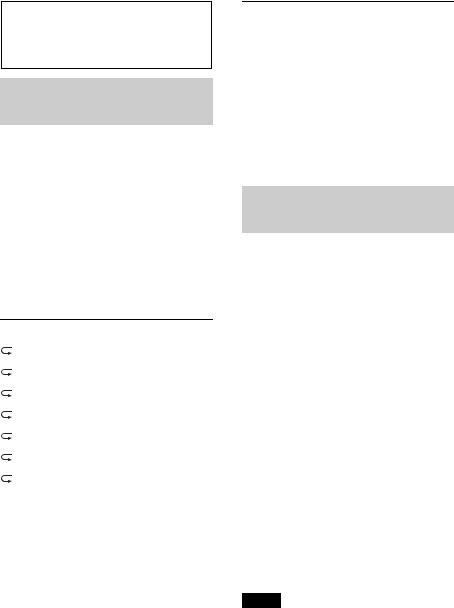
Searching and playing tracks
Playing tracks in various modes
You can listen to tracks repeatedly (repeat play) or in random order (shuffle play). Available play modes differ depending on the selected sound source.
1During playback, press (REP) or(SHUF) repeatedly until the desired play mode appears.
Playback in selected play mode may take time to start.
Repeat play
|
Select |
To play |
|
TRACK |
track repeatedly. |
|
|
|
|
ALBUM |
album repeatedly. |
|
|
|
|
PODCAST*1 |
podcast repeatedly. |
|
ARTIST*1 |
artist repeatedly. |
|
|
|
|
PLAYLIST*1 |
playlist repeatedly. |
|
|
|
|
GENRE*1 |
genre repeatedly. |
|
OFF |
track in normal order |
|
|
(Normal play). |
|
|
|
|
Shuffle play |
|
|
|
|
|
Select |
To play |
|
|
|
|
SHUF ALBUM |
album in random |
|
|
order. |
|
|
|
|
SHUF DISC*2 |
disc in random order. |
|
|
|
|
SHUF PODCAST*1 |
podcast in random |
|
|
order. |
|
|
|
|
SHUF ARTIST*1 |
artist in random order. |
|
|
|
|
SHUF PLAYLIST*1 |
playlist in random |
12 |
|
order. |
|
|
SHUF GENRE*1 |
genre in random order. |
SHUF DEVICE*3 |
device in random |
|
order. |
|
|
SHUF OFF |
track in normal order |
|
(Normal play). |
|
|
*1 iPod only
*2 CD only
*3 USB and iPod only
Searching a track by name — Quick-BrowZer™
You can search for a track in a CD or USB device easily by category.
1Press  (BROWSE)*.
(BROWSE)*.
The unit enters the Quick-BrowZer mode, and the list of search categories appears.
When the track list appears, press  (BACK) repeatedly until the desired search category appears.
(BACK) repeatedly until the desired search category appears.
* During playback, press  (BROWSE) for more than 2 seconds to directly return to the beginning of the category list (USB only).
(BROWSE) for more than 2 seconds to directly return to the beginning of the category list (USB only).
2Rotate the control dial to select the desired search category, then press it to confirm.
3Repeat step 2 until the desired track is selected.
Playback starts.
To exit the Quick-BrowZer mode, press  (BROWSE).
(BROWSE).
Note
When entering the Quick-BrowZer mode, the repeat/shuffle setting is canceled.
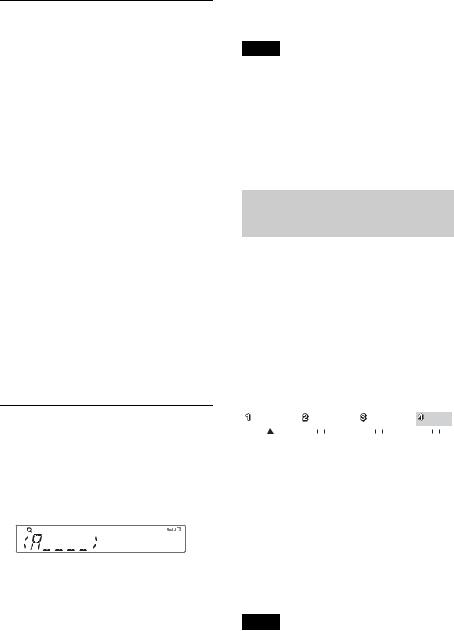
Searching by skip items
— Jump mode
When many items are in a category, you can search the desired item quickly.
1Press + in Quick-BrowZer mode.
The item name will appear.
2Rotate the control dial to select the item near the one desired.
It skips in steps of 10% of the total item number.
3Press the select button.
The display returns to the QuickBrowZer mode and the selected item appears.
4Rotate the control dial to select the desired item and press it.
Playback starts if the selected item is a track.
To cancel Jump mode, press  (BACK) or
(BACK) or
–.
Searching by alphabetical order — Alphabet search
When an iPod is connected to the unit, you can search for a desired item alphabetically.
1Press + in Quick-BrowZer mode.
2Rotate the control dial to select the first letter of the desired item, then press it.
A list of items beginning with the selected letter appears in alphabetical order.
3Rotate the control dial to select the desired item, then press it.
Playback starts if the selected item is a track.
To cancel Alphabet search, press  (BACK) or –.
(BACK) or –.
Notes
•In Alphabet search, a symbol or article (a/an/ the) before the selected letter of the item is excluded.
•Depending on the search item you select, only Jump mode may be available.
•Alphabet search may take some time, depending on the amount of tracks.
Searching a track by listening to track passages — ZAPPIN™
While playing back short track passages in a CD or USB device in sequence, you can search for a track you want to listen to. ZAPPIN mode is suitable for searching for a track in shuffle or shuffle repeat mode.
1Press during playback.
Playback starts from a passage of the next track. You can select the playback time (page 19).
Track
|
|
|
|
|
|
|
|
|
|
|
|
|
|
|
|
|
|
|
|
|
|
|
|
|
|
|
|
|
|
|
|
|
|
|
|
|
|
|
|
|
|
|
|
pressed. |
The part of each track to play |
|||||||||
|
|
|
|
back in ZAPPIN mode. |
||||||
2Press the select button or when a track you want to listen is played back.
The track that you select returns to normal play mode from the beginning.
Pressing  (BACK) also confirms a track to playback.
(BACK) also confirms a track to playback.
Tips
•Press +/– in ZAPPIN mode to skip a track.
•Press / (ALBUM / ) in ZAPPIN mode to skip album.
13

Changing the illumination
Changing the color of display and buttons — Dynamic Color Illuminator
Dynamic Color Illuminator allows you to change the color of the display and buttons on the main unit to match the car’s interior. You can select from 12 preset colors, customized color and 5 preset patterns.
Preset colors:
RED, AMBER, M_AMBER, YELLOW, WHITE, LIGHT GREEN, GREEN, LIGHT BLUE, SKY BLUE, BLUE, PURPLE, PINK.
Preset patterns:
RAINBOW, OCEAN, SUNSET, FOREST, RANDOM.
1Press and hold the select button.
The setup display appears.
2Rotate the control dial until “COLOR” appears, then press it.
3Rotate the control dial to select the desired preset color, then press it.
4Press  (BACK).
(BACK).
Note
If the control dial is rotated rapidly, the color of the display and the buttons may change too quickly.
Customizing the display and button color — Custom Color
You can register a customized color for the display and buttons.
1Press and hold the select button.
The setup display appears.
2Rotate the control dial until “CUSTOM-C” appears, then press it.
3Rotate the control dial until “BASE” appears, then press it.
You can select a preset color as a basis for further customizing.
When you select “BASE,” customized color is overwritten.
4Rotate the control dial to select from “RGB RED,” “RGB GRN,” or “RGB BLUE,” then press it.
5Rotate the control dial to adjust the color range, then press it.
Adjustable color range: “0” – “32.” You cannot set “0” for all color ranges.
6Press  (BACK).
(BACK).
Changing DAY/NIGHT color mode
You can set a different color for DAY/ NIGHT depending on the DIMMER setting.
Color mode |
DIMMER*1 |
DAY |
OFF or AUTO (turn |
|
off the head light*2) |
|
|
NIGHT |
ON or AUTO (turn on |
|
the head light*2) |
|
|
*1 For details on the DIMMER, see page 19.
*2 Available only when the illumination control lead is connected.
1Select “DAYNIGHT” in step 2.
2Select “DAY” or “NIGHT.”
3Customize the preset channel from step 2 to 5.
14

Advanced color setting
Changing the color with sound synchronization
— Sound Synchronization
When you select a preset pattern, sound synchronization becomes effective.
1Press and hold the select button.
The setup display appears.
2Rotate the control dial until “SND SYNC” appears, then press it.
3Rotate the control dial to select “SYNC-ON,” then press it.
4Press  (BACK).
(BACK).
Displaying clear color
— White Menu
You can display the menu more clearly (White) without concern for color setting.
1Press and hold the select button.
The setup display appears.
2Rotate the control dial until “WHT MENU” appears, then press it.
3Rotate the control dial to select “WHITE-ON,” then press it.
4Press  (BACK).
(BACK).
To cancel White Menu, select “OFF” on step 3.
Start up effect
— Start White
When you push on, the color of display and the buttons on the main unit turns white once, and then the color changes to the customized color.
1Press and hold the select button.
The setup display appears.
2Rotate the control dial until “STARTWHT” appears, then press it.
3Rotate the control dial to select “WHITE-ON,” then press it.
4Press  (BACK).
(BACK).
To cancel Start White, select “OFF” on step 3.
15

Sound Settings and
Setup Menu
Changing the sound settings
Adjusting the sound characteristics
1During reception/playback, press the select button.
2Rotate the control dial until the desired menu item appears, then press it.
3Rotate the control dial to select the setting, then press it.
4Press  (BACK).
(BACK).
The following items can be set:
EQ7 PRESET (page 16)
EQ7 SETTING (page 17)
POSITION
SET POSITION (Listening Position setting) (page 17)
ADJ POSITION*1 (Listening Position adjustment) (page 18)
SET SW POS*1 *2 (Subwoofer Position setting) (page 17)
BALANCE
Adjusts the sound balance: “RIGHT-15”
– “CENTER” – “LEFT-15.”
FADER
Adjusts the relative level: “FRONT-15” – “CENTER” – “REAR-15.”
DM+ (page 18)
RB ENH (Rear Bass Enhancer) (page 18)
16
SW LEVEL*2 (Subwoofer Level) Adjusts the subwoofer volume level: “+10 dB” – “0 dB” – “–10 dB.” (“ATT” is displayed at the lowest setting.)
AUX VOL*3 (AUX Volume level) Adjusts the volume level for each connected auxiliary equipment: “+18 dB” – “0 dB” – “–8 dB.”
This setting negates the need to adjust the volume level between sources.
*1 Hidden when “SET POSITION” is set to “OFF.”
*2 When the audio output is set to “SUB-OUT” (page 19).
*3 When AUX source is activated (page 20).
Enjoying sophisticated sound functions — Advanced Sound Engine
Advanced Sound Engine creates an ideal incar sound field with digital signal processing.
Selecting the sound quality
— EQ7 Preset
You can select an equalizer curve from 7 equalizer curves (XPLOD, VOCAL, EDGE, CRUISE, SPACE, GRAVITY, CUSTOM or OFF).
1During reception/playback, press the select button.
2Rotate the control dial until “EQ7 PRESET” appears, then press it.
3Rotate the control dial until the desired equalizer curve appears, then press it.
4Press  (BACK).
(BACK).
To cancel the equalizer curve, select “OFF” in step 3.
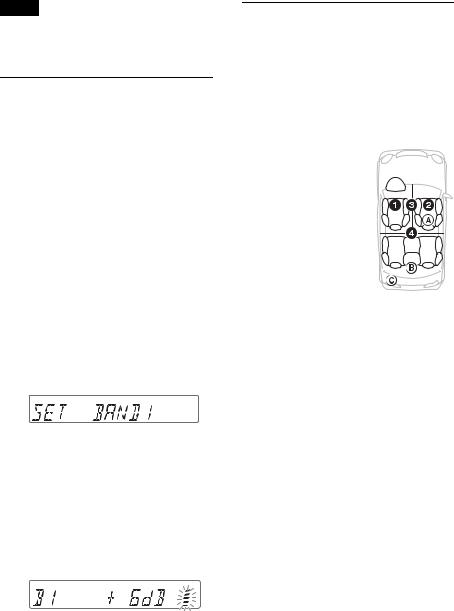
Tip
The equalizer curve setting can be memorized for each source.
Customizing the equalizer curve — EQ7 Setting
“CUSTOM” of EQ7 allows you to make your own equalizer settings.
1Select a source, then press the select button.
2Rotate the control dial until “EQ7 SETTING” appears, then press it.
3Rotate the control dial until “BASE” appears, then press it.
You can select an equalizer curve as a basis for further customizing.
4Rotate the control dial to select the equalizer curve, then press it.
5Setting the equalizer curve.
Rotate the control dial to select the frequency range, then press it.
BAND1: 63 Hz BAND2: 160 Hz BAND3: 400 Hz BAND4: 1 kHz BAND5: 2.5 kHz BAND6: 6.3 kHz BAND7: 16.0 kHz
Rotate the control dial to adjust the volume level, then press it.
The volume level is adjustable in 1 dB steps, from -6 dB to +6 dB.
Repeat steps and to adjust other frequency ranges.
6Press  (BACK) twice.
(BACK) twice.
The equalizer curve is stored in “CUSTOM.”
Optimizing sound by Time Alignment — Listening Position
The unit can simulate a natural sound field by delaying the sound output from each speaker to suit your position.
The options for “POSITION” are indicated below.
FRONT L ( ): Front left FRONT R ( ): Front right
FRONT ( ): Center front
ALL ( ): In the center of 
 your car
your car
OFF: No position set
You can also set the approximate subwoofer position from your listening position if:
–the audio output is set to “SUB-OUT” (page 19).
–the listening position is set besides “OFF.”
The options for “SET SW POS” are indicated below.
NEAR ( ): Near NORMAL ( ): Normal FAR ( ): Far
1During reception/playback, press the select button.
2Rotate the control dial until “SET POSITION” appears, then press it.
3Rotate the control dial to select from “FRONT L,” “FRONT R,” “FRONT” or “ALL,” then press it.
4Rotate the control dial until “SET SW POS” appears, then press it.
17

5Rotate the control dial to select the subwoofer position from “NEAR,” “NORMAL” or “FAR,” then press it.
6Press  (BACK).
(BACK).
To cancel listening position, select “OFF” on step 3.
Adjusting the listening position
You can fine-tune the listening position setting.
1During reception/playback, press the select button.
2Rotate the control dial until “ADJ POSITION” appears, then press it.
3Rotate the control dial to adjust the listening position, then press it.
Adjustable range: “+3” – “CENTER” – “–3.”
4Press  (BACK).
(BACK).
DM+ Advanced
DM+ Advanced improves digitally compressed sound by restoring high frequencies lost in the compression process.
1During playback, press the select button.
2Rotate the control dial until “DM+” appears, then press it.
3Rotate the control dial to select “ON,” then press it.
4Press  (BACK).
(BACK).
Tip
The DM+ setting can be memorized for each source.
Using rear speakers as subwoofer — Rear Bass Enhancer
Rear Bass Enhancer enhances the bass sound by applying the low pass filter setting (page 20) to the rear speakers. This function allows the rear speakers to work as a subwoofer if one is not connected.
1During reception/playback, press the select button.
2Rotate the control dial until “RB ENH” appears, then press it.
3Rotate the control dial to select from “1,” “2” or “3,” then press it.
4Press  (BACK).
(BACK).
18

Adjusting setup items
1Press and hold the select button.
The setup display appears.
2Rotate the control dial until the desired item appears, then press it.
3Rotate the control dial to select the setting, then press it.*
The setting is complete.
4Press  (BACK).
(BACK).
*For CLOCK-ADJ and BTM settings, step 4 is not necessary.
The following items can be set depending on the source and setting:
CLOCK-ADJ (Clock Adjust) (page 4)
CT (Clock Time)
Activates the CT function: “ON,” “OFF” (page 8).
BEEP
Activates the beep sound: “ON,” “OFF.”
CAUT ALM*1 (Caution Alarm) Activates the caution alarm: “ON,” “OFF” (page 4).
AUX-A*1 (AUX Audio)
Activates the AUX source display: “ON,” “OFF” (page 20).
AUTO OFF
Shuts off automatically after a desired time when the unit is turned off: “NO,” “30S (Seconds),” “30M (Minutes),” “60M (Minutes).”
REAR/SUB*1
Switches the audio output: “SUB-OUT” (subwoofer), “REAR-OUT” (power amplifier).
DEMO (Demonstration)
Activates the demonstration: “ON,” “OFF.”
DIMMER
Changes the display brightness.
–“AT”: to dim the display automatically when you turn lights on. (Available only when the illumination control lead is connected.)
–“ON”: to dim the display.
–“OFF”: deactivate the dimmer.
COLOR (Preset Color)
Selects the preset color of the display and buttons on the main unit (page 14).
CUSTOM-C (Custom Color)
Selects a preset color as a basis for further customizing (page 14).
SND SYNC
Selects the color with sound synchronization: “ON,” “OFF.”
WHT MENU
Sets the effect when the source is switched: “ON,” “OFF.”
START-WHT
Sets the start up color: “ON,” “OFF.”
M.DISPLAY (Motion Display)
–“SA”: to show moving patterns and spectrum analyzer.
–“OFF”: to deactivate the Motion Display.
AUTO SCR (Auto Scroll)
Scrolls long items automatically: “ON,” “OFF.”
REGIONAL*2
Restricts reception to a specific region: “ON,” “OFF” (page 8).
ZAP TIME (Zappin Time)
Selects the playback time for the ZAPPIN function.
–“Z.TIME-1 (about 6 seconds),” “Z.TIME-2 (about 15 seconds),” “Z.TIME-3 (about 30 seconds).”
ZAP BEEP (Zappin Beep)
Has the beep sound between track passages: “ON,” “OFF.”
19
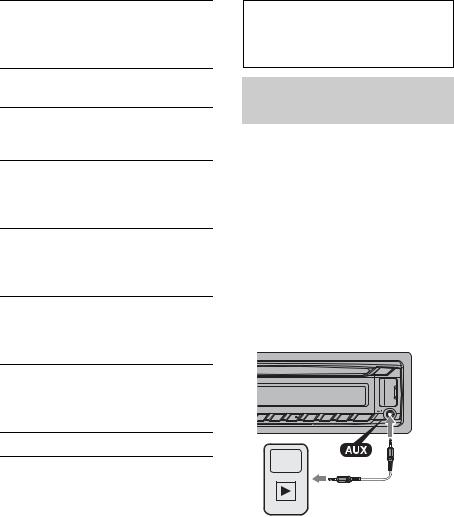
LPF FREQ*3 (Low Pass Filter Frequency) Selects the subwoofer cut-off frequency: “50Hz,” “60Hz,” “80Hz,” “100Hz,” “120Hz.”
LPF SLOP*3 (Low Pass Filter Slope)
Selects the LPF slope: “1,” “2,” “3.”
SW PHASE*4 (Subwoofer Phase)
Selects the subwoofer phase: “NORM,” “REV.”
HPF FREQ (High Pass Filter Frequency) Selects the front/rear speaker cut-off frequency: “OFF,” “50Hz,” “60Hz,” “80Hz,” “100Hz,” “120Hz.”
HPF SLOP (High Pass Filter Slope) Selects the HPF slope (effective only when HPF FREQ is set to other than “OFF”): “1,” “2,” “3.”
LOUDNESS (Dynamic Loudness) Reinforces bass and treble for clear sound at low volume levels: “ON,” “OFF.”
ALO (Automatic Level Optimizer) Adjust the playback volume level of all playback sources to the optimum level: “ON,” “OFF.”
BTM (page 6)
*1 When the unit is turned off.
*2 When FM is received.
*3 When the audio output is set to “SUB-OUT” or Rear Bass Enhancer is set to other than “OFF.”
*4 When the audio output is set to “SUB-OUT.”
20
Using optional equipment
Auxiliary audio equipment
By connecting an optional portable audio device to the AUX input jack (stereo mini jack) on the unit and then simply selecting the source, you can listen on your car speakers.
Connecting the portable audio device
1Turn off the portable audio device.
2Turn down the volume on the unit.
3Connect the portable audio device to the unit with a connecting cord (not supplied)*.
* Be sure to use a straight type plug.
Adjusting the volume level
Be sure to adjust the volume for each connected audio device before playback.
1Turn down the volume on the unit.
2Press repeatedly until
“AUX” appears.
3Start playback of the portable audio device at a moderate volume.
4Set your usual listening volume on the unit.
5Adjust the input level (page 16).

RM-X114 Remote commander
The corresponding buttons on the remote commander control the same functions as those on this unit.
DSPL |
DSPL |
|
MENU* |
|
PRESET + |
SOURCE |
MENU |
DISC + |
|
|
|
</, |
SEEK– |
SOURCE |
|
||
(SEEK –/+) |
SOUND |
DISC – |
|
||
SOUND |
|
PRESET – |
OFF |
OFF |
+ |
|
|
VOL |
VOL (+/–) |
|
– |
|
|
MODE
LIST |
|
SEEK+ |
|
|
R |
TE |
|
EN |
|
ATT
MODE
LIST
m/M
(DISC/ PRESET +/–)
ENTER
ATT
The following buttons on the remote commander have also different buttons/ functions from the unit.
•DSPL (display) button
To change display items.
•SOURCE button
To turn on the power; change the source (Radio/CD/USB/AUX).
•/ (SEEK –/+) buttons
To control Radio/CD/USB, the same as–/+ on the unit.
•SOUND button
The same as the select button on the unit.
•OFF button
To turn off the power; stop the source.
•LIST button
To enter the Quick-BrowZer™ mode.
•/ (DISC/PRESET +/–) buttons
To control CD/USB, the same as / (ALBUM / ) buttons on the unit.
•ATT (attenuate) button
To attenuate the sound. To cancel, press again.
* Not available for this unit.
Note
If the unit is turned off and the display disappears, it cannot be operated with the remote commander unless (SOURCE/OFF) on the unit is pressed, or a disc is inserted to activate the unit first.
21
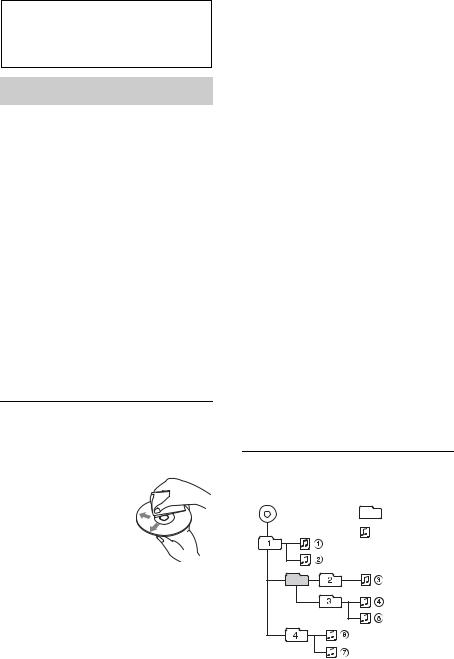
Additional
Information
Precautions
•Cool off the unit beforehand if your car has been parked in direct sunlight.
•Do not leave the front panel or audio devices brought in inside the car, or it may cause malfunction due to high temperature in direct sunlight.
•Power antenna (aerial) extends automatically.
Moisture condensation
Should moisture condensation occur inside the unit, remove the disc and wait for about an hour for it to dry out; otherwise the unit will not operate properly.
To maintain high sound quality
Do not splash liquid onto the unit or discs.
Notes on discs
•Do not expose discs to direct sunlight or heat sources such as hot air ducts, nor leave it in a car parked in direct sunlight.
•Before playing, wipe the discs with a cleaning cloth
from the center out. Do not use solvents such as benzine, thinner, commercially available cleaners.
•This unit is designed to play back discs that conform to the Compact Disc (CD) standard. DualDiscs and some of the music discs encoded with copyright protection technologies do not conform to the Compact Disc (CD) standard, therefore, these discs may not be playable by this unit.
•Discs that this unit CANNOT play
–Discs with labels, stickers, or sticky tape or paper attached. Doing so may cause a malfunction, or may ruin the disc.
–Discs with non-standard shapes (e.g., heart, square, star). Attempting to do so may damage the unit.
–8 cm (3 1/4 in) discs.
Notes on CD-R/CD-RW discs
•The maximum number of: (CD-R/CD-RW only)
–folders (albums): 150 (including root folder)
–files (tracks) and folders: 300 (may less than 300 if folder/file names contain many characters)
–displayable characters for a folder/file name: 32 (Joliet)/64 (Romeo)
•If the multi-session disc begins with a CDDA session, it is recognized as a CD-DA disc, and other sessions are not played back.
•Discs that this unit CANNOT play
–CD-R/CD-RW of poor recording quality.
–CD-R/CD-RW recorded with an incompatible recording device.
–CD-R/CD-RW which is finalized incorrectly.
–CD-R/CD-RW other than those recorded in music CD format or MP3 format conforming to ISO9660 Level 1/Level 2, Joliet/Romeo or multi-session.
Playback order of MP3/WMA/ AAC files
MP3/WMA/AAC |
Folder |
|
(album) |
||
|
||
|
MP3/WMA/ |
|
|
AAC file (track) |
22
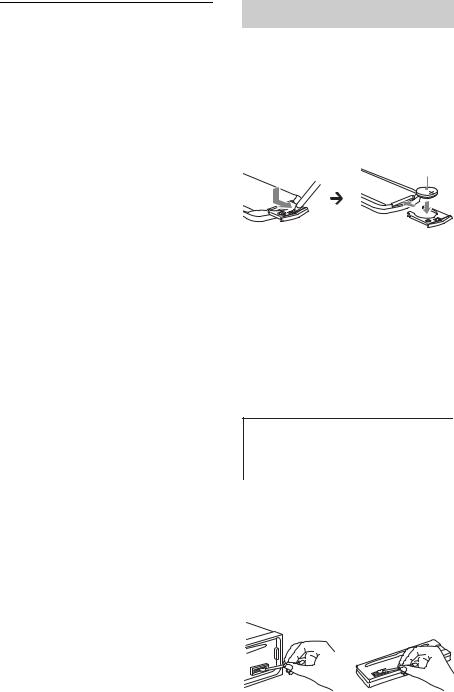
About iPod
•You can connect to the following iPod models. Update your iPod devices to the latest software before use.
Made for
–iPod touch (4th generation) –iPod touch (3rd generation) –iPod touch (2nd generation) –iPod touch (1st generation) –iPod classic
–iPod with video*
–iPod nano (6th generation) –iPod nano (5th generation) –iPod nano (4th generation) –iPod nano (3rd generation) –iPod nano (2nd generation) –iPod nano (1st generation)* –iPhone 4
–iPhone 3GS –iPhone 3G
–iPhone
*Passenger control is not available for
iPod nano (1st generation) or iPod with video.
•“Made for iPod,” and “Made for iPhone” mean that an electronic accessory has been designed to connect specifically to iPod or iPhone, respectively, and has been certified by the developer to meet Apple performance standards. Apple is not responsible for the operation of this device or its compliance with safety and regulatory standards. Please note that the use of this accessory with iPod or iPhone may affect wireless performance.
If you have any questions or problems concerning your unit that are not covered in this manual, consult your nearest Sony dealer.
Maintenance
Replacing the lithium battery of the remote commander
When the battery becomes weak, the range of the remote commander becomes shorter. Replace the battery with a new CR2025 lithium battery. Use of any other battery may present a risk of fire or explosion.
+ side up
Notes on the lithium battery
•Keep the lithium battery out of the reach of children. Should the battery be swallowed, immediately consult a doctor.
•Wipe the battery with a dry cloth to assure a good contact.
•Be sure to observe the correct polarity when installing the battery.
•Do not hold the battery with metallic tweezers, otherwise a short-circuit may occur.
•Do not expose the battery to excessive heat such as direct sunlight, fire or the like.
WARNING
Battery may explode if mistreated.
Do not recharge, disassemble, or dispose of in fire.
Cleaning the connectors
The unit may not function properly if the connectors between the unit and the front panel are not clean. In order to prevent this, detach the front panel (page 4) and clean the connectors with a cotton swab. Do not apply too much force. Otherwise, the connectors may be damaged.
23

Notes
•For safety, turn off the ignition before cleaning the connectors, and remove the key from the ignition switch.
•Never touch the connectors directly with your fingers or with any metal device.
Specifications
Tuner section
FM
Tuning range: 87.5 – 108.0 MHz
Antenna (aerial) terminal:
External antenna (aerial) connector
Intermediate frequency: 25 kHz Usable sensitivity: 8 dBf Selectivity: 75 dB at 400 kHz Signal-to-noise ratio: 80 dB (stereo) Separation: 50 dB at 1 kHz Frequency response: 20 – 15,000 Hz
MW/LW
Tuning range:
MW: 531 – 1,602 kHz LW: 153 – 279 kHz
Antenna (aerial) terminal:
External antenna (aerial) connector
Intermediate frequency:
9,124.5 kHz or 9,115.5 kHz/4.5 kHz Sensitivity: MW: 26 μV, LW: 45 μV
CD Player section
Signal-to-noise ratio: 120 dB Frequency response: 10 – 20,000 Hz
Wow and flutter: Below measurable limit
USB Player section
Interface: USB (Full-speed)
Maximum current: 1 A
Power amplifier section
Output: Speaker outputs
Speaker impedance: 4 – 8 ohms
Maximum power output: 52 W × 4 (at 4 ohms)
General
Outputs:
Audio outputs terminal (front, rear/sub switchable)
Power antenna (aerial) relay control terminal Power amplifier control terminal
Inputs:
Remote controller input terminal Antenna (aerial) input terminal AUX input jack (stereo mini jack) USB signal input connector
Power requirements: 12 V DC car battery (negative ground (earth))
Dimensions: Approx. 178 × 50 × 179 mm (7 1/8 × 2 × 7 1/8 in) (w/h/d)
Mounting dimensions: Approx. 182 × 53 × 162 mm (7 1/4 × 2 1/8 × 6 1/2 in) (w/h/d)
Mass: Approx. 1.2 kg (2 lb 11 oz)
Supplied accessory:
Parts for installation and connections (1 set)
Optional accessories/equipment:
Remote commander: RM-X114
USB connection cable for iPod: RC-100IP
Your dealer may not handle some of the above listed accessories. Please ask the dealer for detailed information.
Design and specifications are subject to change without notice.
24

Troubleshooting
The following checklist will help you remedy problems you may encounter with your unit. Before going through the checklist below, check the connection and operating procedures.
For details on using the fuse and removing the unit from the dashboard, refer to the installation/connections manual supplied with this unit.
If the problem is not solved, visit the support site on the back cover.
General
No power is being supplied to the unit.
Check the connection or fuse.
If the unit is turned off and the display disappears, it cannot be operated with the remote commander.
– Turn on the unit.
The power antenna (aerial) does not extend.
The power antenna (aerial) does not have a relay box.
No sound.
The ATT function is activated, or the Telephone ATT function (when the interface cable of a car telephone is connected to the ATT lead) is activated.
The position of the fader control “FADER” is not set for a 2-speaker system.
No beep sound.
The beep sound is canceled (page 19).
An optional power amplifier is connected and you are not using the built-in amplifier.
The contents of the memory have been erased.
The power supply lead or battery has been disconnected or it is not connected properly.
Stored stations and correct time are erased. The fuse has blown.
Makes noise when the position of the ignition is switched.
The leads are not matched correctly with the car’s accessory power connector.
During playback or reception, demonstration mode starts.
If no operation is performed for 5 minutes with “DEMO-ON” set, demonstration mode starts.
– Set “DEMO-OFF” (page 19).
The display disappears from/does not appear in the display window.
The dimmer is set to “DIM-ON” (page 19).
The display disappears if you press and hold
.
–Press on the unit until the display appears.
The connectors are dirty (page 23).
The Auto Off function does not operate.
The unit is turned on. The Auto Off function activates after turning off the unit.
– Turn off the unit.
Radio reception
The stations cannot be received.
The sound is hampered by noises.
The connection is not correct.
–Connect a power antenna (aerial) control lead (blue) or accessory power supply lead (red) to the power supply lead of a car’s antenna (aerial) booster (only when your car has built-in radio antenna (aerial) in the rear/side glass).
–Check the connection of the car antenna (aerial).
–If the auto antenna (aerial) will not go up, check the connection of the power antenna (aerial) control lead.
Preset tuning is not possible.
Store the correct frequency in the memory.
The broadcast signal is too weak.
Automatic tuning is not possible.
The broadcast signal is too weak.
– Perform manual tuning.
25

RDS
The SEEK starts after a few seconds of listening.
The station is non-TP or has weak signal.
– Deactivate TA (page 7).
No traffic announcements.
Activate TA (page 7).
The station does not broadcast any traffic announcements despite being TP.
– Tune in another station.
PTY displays “- - - - - - - -.”
The current station is not an RDS station.
RDS data has not been received.
The station does not specify the program type.
Program service name flashes.
There is no alternative frequency for the current station.
–Press +/– while the program service name is flashing. “PI SEEK” appears and the unit starts searching for another frequency with the same PI (Program Identification) data.
CD playback
The disc cannot be loaded.
Another disc is already loaded.
The disc has been forcibly inserted upside down or in the wrong way.
The disc does not play back.
Defective or dirty disc.
The CD-Rs/CD-RWs are not for audio use (page 22).
MP3/WMA/AAC files cannot be played back.
The disc is incompatible with the MP3/WMA/ AAC format and version. For details on playable discs and formats, visit the support site.
MP3/WMA/AAC files take longer to play back than others.
The following discs take a longer time to start playback.
–a disc recorded with a complicated tree structure.
–a disc recorded in Multi Session.
–a disc to which data can be added.
The display items do not scroll.
For discs with very many characters, those may not scroll.
“AUTO SCR” is set to “OFF.”
–Set “A.SCRL-ON” (page 19).
–Press and hold (SCRL).
The sound skips.
Installation is not correct.
–Install the unit at an angle of less than 45° in a sturdy part of the car.
Defective or dirty disc.
USB playback
You cannot play back items via a USB hub.
This unit cannot recognize USB devices via a USB hub.
Cannot play back items.
A USB device does not work.
– Reconnect it.
The USB device takes longer to play back.
The USB device contains files with a complicated tree structure.
The sound is intermittent.
The sound may be intermittent at a high-bit- rate of more than 320 kbps.
26

Error displays/Messages
CHECKING
The unit is confirming the connection of a USB device.
–Wait until confirming the connection is finished.
ERROR
The disc is dirty or inserted upside down.
–Clean or insert the disc correctly.
A blank disc has been inserted.
The disc cannot play due to a problem.
–Insert another disc.
USB device was not automatically recognized.
–Reconnect it again.
Press to remove the disc.
FAILURE
The connection of speakers/amplifiers is incorrect.
–See the installation/connections manual of this model to check the connection.
HUB NO SUPRT (Hubs Not Supported)
USB hub is not supported on this unit.
NO AF
There is no alternative frequency for the current station.
–Press +/– while the program service name is flashing. The unit starts searching for another frequency with the same PI (Program Identification) data (“PI SEEK” appears).
NO DEV (No Device)
USB is selected as source without a USB device connected. A USB device or a USB cable has been disconnected during playback.
–Be sure to connect a USB device and USB cable.
NO MUSIC
The disc or USB device does not contain a music file.
–Insert a music CD in this unit.
–Connect a USB device with a music file in it.
NO NAME
A disc/album/artist/track name is not written in the track.
NOT FOUND
There is no item beginning with the selected letter in Alphabet search.
NO TP
The unit will continue searching for available TP stations.
OFFSET
There may be an internal malfunction.
–Check the connection. If the error indication remains on in the display, consult your nearest Sony dealer.
OVERLOAD
USB device is overloaded.
–Disconnect the USB device, then change the source by pressing .
–Indicates that the USB device is out of order, or an unsupported device is connected.
READ
The unit is reading all track and album information on the disc.
–Wait until reading is complete and playback starts automatically. Depending on the disc structure, it may take more than a minute.
USB NO SUPRT (USB Not Supported)
The connected USB device is not supported.
–For details on the compatibility of your USB device, visit the support site.
“ 


 ” or “
” or “ 


 ”
”
During reverse or fast-forward, you have reached the beginning or the end of the disc and you cannot go any further.
“ ”
”
The character cannot be displayed with the unit.
If these solutions do not help improve the situation, consult your nearest Sony dealer. If you take the unit to be repaired because of CD playback trouble, bring the disc that was used at the time the problem began.
27

Wichtig!
Bitte nehmen Sie sich etwas Zeit, um den Geräte-Pass vollständig auszufüllen. Dieser befindet sich auf der hinteren Umschlagseite dieser Bedienungsanleitung.
Montieren Sie dieses Gerät aus Sicherheitsgründen im Armaturenbrett des Fahrzeugs. Zur Installation und zum Anschluss siehe die mitgelieferte Installations-/Anschlussanleitung.
Dieses Etikett befindet sich an der Unterseite des Gehäuses.
Hinweis für Kunden: Die folgenden Informationen gelten nur für Geräte, die in Ländern verkauft werden, in denen EU-Richtlinien gelten
Der Hersteller dieses Produktes ist Sony Corporation, 1-7-1 Konan Minato-ku Tokio, 108-0075 Japan. Bevollmächtigter für EMV und Produktsicherheit ist Sony Deutschland GmbH, Hedelfinger Strasse 61, 70327 Stuttgart, Deutschland. Für Kundendienstoder Garantieangelegenheiten wenden Sie sich bitte an die in Kundendienstoder Garantiedokumenten genannten Adressen.
Entsorgung von gebrauchten elektrischen und elektronischen Geräten (anzuwenden in den Ländern  der Europäischen Union und anderen europäischen
der Europäischen Union und anderen europäischen
Ländern mit einem separaten Sammelsystem für diese Geräte)
Das Symbol auf dem Produkt oder seiner Verpackung weist darauf hin, dass dieses Produkt nicht als normaler Haushaltsabfall zu behandeln ist, sondern an einer Annahmestelle für das Recycling von elektrischen und elektronischen Geräten abgegeben werden muss. Durch Ihren Beitrag zum korrekten Entsorgen dieses Produkts schützen Sie die Umwelt und die Gesundheit Ihrer Mitmenschen. Umwelt und Gesundheit werden durch falsches Entsorgen gefährdet. Materialrecycling hilft, den Verbrauch von Rohstoffen zu verringern. Weitere Informationen zum Recycling dieses Produkts erhalten Sie bei Ihrer Gemeindeverwaltung, den kommunalen Entsorgungsbetrieben oder dem Geschäft, in dem Sie das Produkt gekauft haben.
ZAPPIN und Quick-BrowZer sind Markenzeichen der Sony Corporation.
Windows Media ist ein eingetragenes Markenzeichen oder Markenzeichen der Microsoft Corporation in den
USA und/oder anderen Ländern.
Dieses Produkt enthält Technologie, die bestimmten Schutzund Urheberrechten von Microsoft unterliegt. Die Benutzung oder Verteilung dieser Technologie außerhalb dieses Produktes ohne entsprechende Lizenz(en) von Microsoft ist verboten.
iPhone, iPod, iPod classic, iPod nano und iPod touch sind Markenzeichen der Apple Inc., die in den USA und anderen Ländern eingetragen sind.
2

MPEG Layer-3 Audiocodiertechnologie und Patente lizenziert von Fraunhofer IIS und Thomson.
Warnhinweis, wenn die Zündung Ihres Fahrzeugs nicht über eine Zubehörposition (ACC oder I) verfügt
Aktivieren Sie unbedingt die Abschaltautomatik (Seite 24). Nach dem Ausschalten wird das Gerät dann nach der voreingestellten Zeit automatisch vollständig abgeschaltet, so dass der Autobatterie kein Strom mehr entzogen wird. Wenn Sie die Abschaltautomatik nicht aktivieren, müssen Sie jedes Mal,
wenn Sie die Zündung ausschalten, die Taste gedrückt halten,
bis die Anzeige ausgeblendet wird.
3

Inhalt
Vorbereitungen . . . . . . . . . . . . . . . . . . . . . . . . . . . . . . . . . . . . . . . . . . . . . . . . . . . . 5
Beenden des DEMO-Modus. . . . . . . . . . . . . . . . . . . . . . . . . . . . . . . . . . . . . . . . . . . . . . . . 5 Einstellen der Uhr . . . . . . . . . . . . . . . . . . . . . . . . . . . . . . . . . . . . . . . . . . . . . . . . . . . . . . . . 5 Abnehmen der Frontplatte . . . . . . . . . . . . . . . . . . . . . . . . . . . . . . . . . . . . . . . . . . . . . . . . . 6
Lage und Funktion der Bedienelemente. . . . . . . . . . . . . . . . . . . . . . . . . . . . . . . . 7 Radio . . . . . . . . . . . . . . . . . . . . . . . . . . . . . . . . . . . . . . . . . . . . . . . . . . . . . . . . . . . . . 8
Speichern und Empfangen von Sendern . . . . . . . . . . . . . . . . . . . . . . . . . . . . . . . . . . . . . 8 RDS. . . . . . . . . . . . . . . . . . . . . . . . . . . . . . . . . . . . . . . . . . . . . . . . . . . . . . . . . . . . . . . . . . . . . 9
CD . . . . . . . . . . . . . . . . . . . . . . . . . . . . . . . . . . . . . . . . . . . . . . . . . . . . . . . . . . . . . . 11
Wiedergeben einer CD . . . . . . . . . . . . . . . . . . . . . . . . . . . . . . . . . . . . . . . . . . . . . . . . . . . 11
USB-Geräte . . . . . . . . . . . . . . . . . . . . . . . . . . . . . . . . . . . . . . . . . . . . . . . . . . . . . . . 12
Wiedergabe mit einem USB-Gerät . . . . . . . . . . . . . . . . . . . . . . . . . . . . . . . . . . . . . . . . . 12
iPod . . . . . . . . . . . . . . . . . . . . . . . . . . . . . . . . . . . . . . . . . . . . . . . . . . . . . . . . . . . . . 13
Wiedergabe mit einem iPod . . . . . . . . . . . . . . . . . . . . . . . . . . . . . . . . . . . . . . . . . . . . . . . 13 Direktes Bedienen eines iPod — Direkte Steuerung. . . . . . . . . . . . . . . . . . . . . . . . . . . 14
Suchen und Wiedergeben von Titeln . . . . . . . . . . . . . . . . . . . . . . . . . . . . . . . . . 14
Wiedergeben von Titeln in verschiedenen Modi . . . . . . . . . . . . . . . . . . . . . . . . . . . . . 14 Suchen nach einem Titel anhand seines Namens — Quick-BrowZer™. . . . . . . . . . . 15 Suchen nach einem Titel durch Anspielen der Titel — ZAPPIN™. . . . . . . . . . . . . . . 17
Ändern der Beleuchtung. . . . . . . . . . . . . . . . . . . . . . . . . . . . . . . . . . . . . . . . . . . . 17
Ändern der Displayund Tastenfarbe — Dynamische farbige Beleuchtung . . . . . . 17 Weitere Funktionen zur Farbeinstellung . . . . . . . . . . . . . . . . . . . . . . . . . . . . . . . . . . . . 18
Klangeinstellungen und Setup-Menü . . . . . . . . . . . . . . . . . . . . . . . . . . . . . . . . . 20
Ändern der Klangeinstellungen . . . . . . . . . . . . . . . . . . . . . . . . . . . . . . . . . . . . . . . . . . . . 20 Verwenden der erweiterten Klangfunktionen — Erweiterte Sound-Engine. . . . . . . 21 Einstellen von Konfigurationsoptionen . . . . . . . . . . . . . . . . . . . . . . . . . . . . . . . . . . . . . 23
Verwenden gesondert erhältlicher Geräte . . . . . . . . . . . . . . . . . . . . . . . . . . . . . 25
Zusätzliche Audiogeräte . . . . . . . . . . . . . . . . . . . . . . . . . . . . . . . . . . . . . . . . . . . . . . . . . . 25
Fernbedienung RM-X114 . . . . . . . . . . . . . . . . . . . . . . . . . . . . . . . . . . . . . . . . . . . . . . . . . 26
Weitere Informationen . . . . . . . . . . . . . . . . . . . . . . . . . . . . . . . . . . . . . . . . . . . . . 27
Sicherheitsmaßnahmen. . . . . . . . . . . . . . . . . . . . . . . . . . . . . . . . . . . . . . . . . . . . . . . . . . . 27
Wartung. . . . . . . . . . . . . . . . . . . . . . . . . . . . . . . . . . . . . . . . . . . . . . . . . . . . . . . . . . . . . . . . 28
Technische Daten. . . . . . . . . . . . . . . . . . . . . . . . . . . . . . . . . . . . . . . . . . . . . . . . . . . . . . . . 29
Störungsbehebung . . . . . . . . . . . . . . . . . . . . . . . . . . . . . . . . . . . . . . . . . . . . . . . . . . . . . . . 30
4
